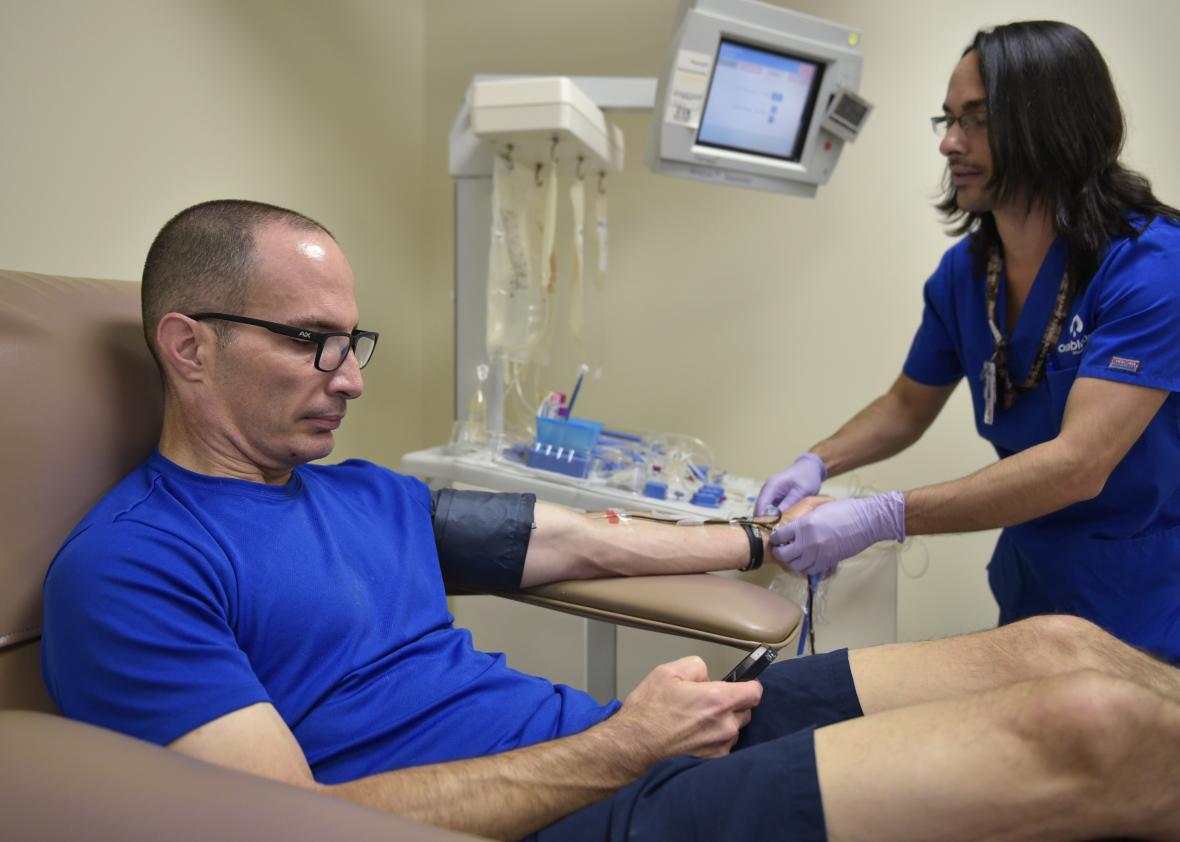The idea of injecting yourself with blood extracted from someone younger than you in order to prolong your own life feels like it must be a parody of our aging-phobic culture. But “young blood” transfusions are not a facet of vampire fiction—they’re a real possibility. There may not be “blood boys” running around like on Silicon Valley (at least not yet), but a Bay Area startup called Ambrosia is experimenting with efforts to turn back the clock by injecting the plasma of young donors into old venture capitalists.
Technology reporter Sally Adee recently embedded with the Bay Area startup for a feature in the New Scientist. As Adee reports, there’s been a lot of skepticism around the value of transfusing young people’s blood into the bodies of older people. And most of it’s valid. But, she writes, scientists are nonetheless narrowing in on why blood plasma, the yellowish soup leftover after the blood cells are removed, might have beneficial properties:
Plasma is rich in all sorts of proteins and other compounds, which could hold the key to what makes young people young and old people old. Not that we know what all these components are. But we do know that their amounts and ratios change as we age. For example, old blood has higher levels of inflammatory compounds that damage tissues they reach. Inflammation has been linked to cancer, heart disease and depression. Younger blood, by contrast, is characterised by a higher concentration of stimulating and restorative factors.
What this passage really highlights is the continued mysteries surrounding blood’s anti-aging properties. Like, what actually is young blood? Will these transfusions actually have any real effect on aging? What would the mechanism of that effect be?
The scientific answers we have to these ideas are still somewhat nebulous. The idea of anti-aging properties in “young blood” has actually been around for some time. In the 1950s, researchers literally stitched old and young mice together and watched what happened. They found that the old mice seemed to regenerate with shinier fur and faster reflexes. Despite enormous gaps in our understanding, many contemporary startups were convinced these rodent studies were enough to validate human experimentation.
That’s why Ambrosia, the most infamous of these operations, now transfuses the blood of people age 16–25 into healthy “patients” over 35, which Adee saw firsthand. To study the impact of the transfusion, the company runs biomarker tests to look at things like inflammation and record, quite simply, how patients feel. It’s clear that some people (mostly those who can afford to make immortality a hobby) love this vampiric procedure. But average Americans aren’t actually knocking down Ambrosia’s door, perhaps due to the relative strangeness of the procedure, the lack of good evidence, or the cost.
And it is costly: The company doesn’t appear to have raised any money from investors so instead, it’s charging each of its subjects $8,000 to be enrolled in the study (an ethically dubious research practice, to say the least). Even the most serious startup in the field, the Stanford-based company Alkahest, isn’t going to be named a “unicorn” anytime soon. In 2015, it received $37.5 million from the plasma company Grifols to help fund an Alzheimer’s transfusion study, but the vein seems to have since dried up.
By pulling back the curtain, this story shows what the young blood movement really is: Silicon Valley’s take on Goop. By taking an idea that sounds “science-y” and overestimating the evidence it’ll work, these companies can charge people thousands of dollars for the privilege of being a human guinea pig.
Neither Ambrosia nor Alkahest have provided any hard data showing positive effects of their processes (though Adee reports Alkahest will be sharing something in November). That’s not surprising, given that all of the work on this topic is mostly dominated by biotech companies seeking profits. But it’s still disappointing that private interests and poor study designs continue to dominate this field. If we’re to answer any of the lingering questions of young blood (and old blood), we’re going to need a lot of real, robust research. Until then, we’ll all just have to try and age gracefully.
